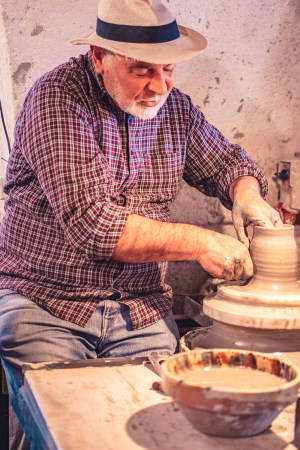In conversation with Mimmo, a potter from Grottaglie

Everyone who grew up in Puglia has at least one piece from Grottaglie. These usually aren’t everyday items, but cherished pieces that are taken out of credenzas for special occasions and Sunday lunches. They take pride of place on nonna’s embroidered tablecloth and are passed down from one generation to another.
While the town of Grottaglie owes its name to the numerous caves that can be found in the area, that’s not the reason why it’s famous all over the world. It owes its fame to its pottery-making heritage, one of the longest-standing in Europe.
Whenever we go to Grottaglie, we like to pay a visit to Mimmo. His family-run studio is one of the most important in Grottaglie and is surrounded by a beautiful garden, it’s also one of the highlights of our road trip itineraries.
He’s been working as a potter his entire life and whenever he sits down at the lathe, he’s able to regale us with stories and wise words – we could spend hours simply listening in utter contemplation and fascination, which is what happened the last time we were there.

“Pottery-making is the oldest technology, did you know?” he tells us after we settled in. “Someone probably discovered that, after a bonfire and rain, the ground had become rock-hard. And so experimented, leading to the techniques we still employ today”.
However, it’s in the 1600s that Grottaglie starts to develop an industry around ceramics. The Quartiere delle Ceramiche has been the one place in town where potters worked since the eighteenth century. You can still visit it today and you can find here many studios and galleries, some housed in caves, along with the museum dedicated to – you guessed it – ceramics.
“When I start working a piece of clay I never know what’s going to come out … a bowl, a plate, a cup, I simply don’t know” he tells us. “Very much like life, isn’t it? I let the clay guide me, for this reason, no piece is alike.”
Besides crockery, dinnerware and the like, there are a few other items that are unique to Puglia. We start talking about pumi or pigne, as we’re surrounded by them here in the studio. They represent a flower bud decorated with acanthus leaves, a symbol of spring and of nature’s rebirth. “They used to be gifted as a sign of good luck at any important event” Mimmo tells us. In the past, they adorned the corners of the balconies of noble palaces throughout Puglia.
“And you know the story behind the pupe e cavalieri don’t you?”
These ceramic busts, of a mustached man dressed in women’s clothes and of a woman in short dresses and they’re unique to Puglia.
 “It goes way back to the seventeenth century when the Spanish ruled over Puglia. The local landowners exercised absolute authority over the lands assigned to them, including the ius prime noctis, the right to spend the wedding night with the bride of a servant.
“It goes way back to the seventeenth century when the Spanish ruled over Puglia. The local landowners exercised absolute authority over the lands assigned to them, including the ius prime noctis, the right to spend the wedding night with the bride of a servant.
Well, one time a servant decided to stand up against this abuse. He disguised himself as a woman to offer himself to the Spanish lord, others say that he disguised himself to murder him, but he was found out eventually and executed. He didn’t die in vain, however, a riot ensued and this unjust law abolished”.
“It only takes a couple of seconds for the clay to completely transform, see” he said, pointing to the clay he was working, which was slowly transforming into a bowl.
“Now we have electric lathes, but back in the day they’d have lathes with pedals and you’d end up with a much bigger foot because of all the pedaling” – we all burst laughing.
We’ve been here before and we’ll probably be back again, but each time is as special as the first time, which is why decided to include a visit to his studio in our tours. That’s how we craft our itineraries, it’s not our head that guides us but our heart.
Want to find out more? Drop us a line.
